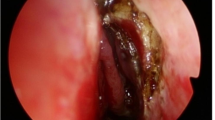Abstract
To evaluate the outcome and complications of Endoscopic endonasal Dacryocystorhinostomy (DCR) using an inferiorly based mucosal flap as compared to a conventional posteriorly based mucosal flap with flap preservation and no stenting. 36 patients presenting with nasolacrimal duct obstruction were divided into two groups: the first group underwent endoscopic DCR using an inferiorly based mucosal flap, and the other group used a posteriorly based mucosal flap. In both groups, the mucosal flap was preserved, and bone was removed using Kerrison’s punch. No stenting was done in any of the cases. The patency of the ostia was determined by syringing, and nasal endoscopy was done to look at the neo-ostium at follow-up visits to determine success and complications in each group. All 18 cases in the inferiorly based flap group had patent ostia with good mucosalization of the neo-ostium at 6-month follow-up. 3 of the 18 cases in the conventional posteriorly based flap group had failure due to granulation tissue formation around the neo-ostium. The use of an inferiorly based mucosal flap is easy to fashion and reposition at the end of the surgery. This technique has a good outcome with patent ostia during the follow-up period of 6 months.






Similar content being viewed by others
References
Karim et al (2011) A comparison of external and endoscopic endonasal dacryocystorhinostomy for acquired nasolacrimal duct obstruction. Clin Ophthalmol 5979–5989
Kirtane MV et al (2013) Endoscopic dacryocystorhinostomy with flap suturing. Indian J Otolaryngol Head Neck Surg 65(suppl 2):S236-s241. https://doi.org/10.1007/s12070-011-0354-z
Herzallah I, Alzuraiqi B, Bawazeer N, Marglani O, Alherabi A, Mohamed SK et al (2015) Endoscopic dacryocystorhinostomy (DCR): a comparative study between powered and non-powered technique. J Otolaryngol Head Neck Surg 44:56
Hassan MA, Badreldin MH, El-Nahriry T, El-Tabbakh MT (2018) I-shaped incision with mucosal flap preserving technique in endoscopic dacrocystorhinostomy. Egypt J Otolaryngol 34:173–178
Keren S, Abergel A, Manor A (2020) Endoscopic dacryocystorhinostomy: reasons for failure. Eye 34:948–953
Deviprasad D, Mahesh SG, Pujary K, Pillai S, Mallick SA, Jain V (2009) Endonasal endoscopic dacryocystorhinostomy: our experience. Indian J Otolaryngol Head Neck Surg 223–226
Bandadka R, Haridas SM, Doddarangaiah PM (2019) Powered endoscopic endonasal dacryocystorhinostomy using inferiorly based mucosal flap: our experience. Int J Otorhinolaryngol Head Neck Surg 5(4):936–940
Sheikh S, Vaze VV, Bajaj A, Bhalachandra (2019) Merits of kerrisons punch over powered drill in endonasal DCR. Int J Otorhinolaryngol Head Neck Surg 5(2):387–390
Funding
The authors have not disclosed any funding.
Author information
Authors and Affiliations
Corresponding author
Ethics declarations
Conflict of interest
The authors declare that they have no potential conflict of interest.
Ethical Approval
The study was done in line with the principles of the Declaration of Helsinki. Approval for the study was granted by the Institutional Ethics committee prior to the commencement of the study.
Informed Consent
Informed consent was obtained from all individual participants for participation in the study and publishing of the data collected as part of the study.
Additional information
Publisher’s Note
Springer Nature remains neutral with regard to jurisdictional claims in published maps and institutional affiliations.
Rights and permissions
Springer Nature or its licensor (e.g. a society or other partner) holds exclusive rights to this article under a publishing agreement with the author(s) or other rightsholder(s); author self-archiving of the accepted manuscript version of this article is solely governed by the terms of such publishing agreement and applicable law.
About this article
Cite this article
Alokkan, J., Swathi, R., Viswanatha, B. et al. A Comparative Study of Endoscopic Endonasal Dacryocystorhinostomy Using an Inferiorly Based Flap Versus a Posteriorly Based Flap. Indian J Otolaryngol Head Neck Surg 76, 1882–1885 (2024). https://doi.org/10.1007/s12070-023-04435-4
Received:
Accepted:
Published:
Issue Date:
DOI: https://doi.org/10.1007/s12070-023-04435-4




